
A spectacular tribute to the nation
- Shveta Arora
e-mail: shwetananoop@gmail.com
Photos: Anoop Arora
September 14, 2015
It was a mega event, with something of the pomp and show of a place like
The Kingdom of Dreams in North India. There was a galaxy of sponsors
and guests, and a huge stage with cut-outs of freedom fighters and many
dancers, thumping music, great lighting effects, patriotic songs and a
variety of tri-color costumes. It was an event with a patriotic theme,
where dances with contemporary sensibilities were enjoyed by all alike.
Jashn-e-Azadi was celebrated on the 9th of August at the Weight Lifting
Auditorium of the Jawaharlal Nehru Stadium, by the Nehru Bal Sangh. It
was about 50 years ago that a group of six students started the Nehru
Bal Sangh with the blessings of the then PM, Lal Bahadur Shastri. It is
now operating in 18 states of the country and has till date organized 29
national level integration camps in various cities across the country.
Sadhya, a unit of performing arts, is one of the leading dance companies
of India, formed by Santosh Nair, the artistic director of the company.
It has provided a platform to upcoming talents and promotes the passion
for dance in the young. Nair began his journey as a dancer under his
father Kalamandalam Padmanabhan in 1986. He was further trained by
Sadanam Balakrishnan and learnt modern dance with Narendra Sharma of
Bhumika Creative Dance Centre. He has also learnt Mayurbhanj Chhau under
Guru Janmejoy Saibabu.
Slide show
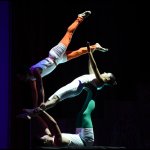
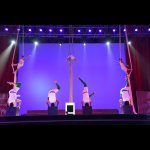
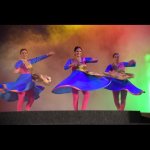
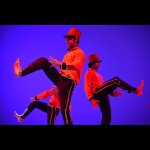
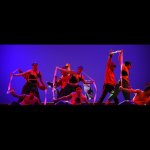
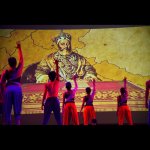
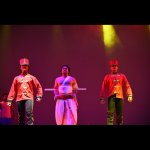
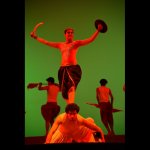
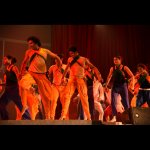
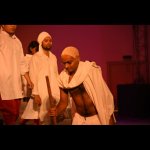
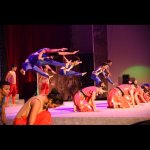
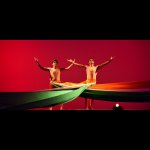
The emcees, Sahil Bajaj and Naina, were quite entertaining. Apart from
the huge portraits and cutouts of freedom fighters, the stage had scenes
from the protests of the freedom struggle. The lighting was
appropriately done; the costumes were comprised mostly of the tricolour
or were otherwise quite colourful. At times, the dancers wore swirling
white skirts. The tale of the freedom struggle was well-researched and
narrated in a multimedia presentation, which had many original clippings
and videos. This added to the interest value. The music was catchy, the
dance sequences were well-rehearsed and choreographed, and together
with all this, the use of colourful props made the event a success.
The show started with “Vande Mataram” in its slow, lilting tune, to
which dancers did gymnastics - headstands, leg splits, lifts and
formations, three-tier lifts on tables and stools. The main attraction
of this piece was three gymnasts on the aerial silk hung from the
ceiling. The dancers wore white costumes spangled with silver. The next
song “Jai Jai Mataram,” a fast-paced composition, was danced in Kathak
style. A few dancers held colourful umbrellas while contemporary dancers
in yellow and orange skirts, danced in the foreground. Some dancers
held poles with yellow flags hung on both sides, rotating them. It
became a colourful medley of dancers and flags.
The narration began with the East India Company (1757-1858) taking over
the reins of India after the battles in Plassey and Buxar. The dancers
enacting the soldiers carried the British flag, whereas the downtrodden
Indians were shown struggling, ‘bound’ by long elastic cloth bands. The
first revolt is said to have started in Meerut by Mangal Pandey in 1857.
The song “Mangal Mangal” was from the Aamir Khan starrer ‘Mangal
Pandey’ to which contemporary Chhau was danced. “Bhaag bhaag re firangi”
(run away you foreigner), then the war with Rani ki Jhansi was
portrayed with powerful dancing by the lead female dancer. The dancers
did formations with red flags.
The next historical event portrayed was that of Bahadur Shah Zafar being
taken captive, and the rule of the British Queen being established in
India. The Jallianwala Bagh episode, which took place on April 13, 1919,
the firing orders given by General Dyer that left 1000 dead and 2500
injured was enacted well.
The train from Kakori was robbed by the Indian mutineers on August 9,
1925. Other freedom fighters - Chandrashekhar Azad, Bhagat Singh, etc -
were also portrayed. The incident of the bombing of the legislative
assembly was shown through videos. These sequences were enacted on the
stage and also off the stage in the aisles and the spaces in the
auditorium. “Sarfaroshi ki tamanna,” “Mera rang de basanti chola,” “Ae
watan ae watan” - all these film songs stirred the patriotic emotions.
The hanging of Bhagat Singh by the British was also enacted the same way
- suddenly you would turn in your seat and find the dancers walking
past you.
The next chapter in the history shown was the formation of the Congress
party and the popularity of Lal, Bal, Pal (Lala Lajpat Rai, Bal
Gangadhar Tilak and Bipin Chandra Pal) and Khan Abdul Ghaffar Khan or
Frontier Gandhi. The song “Kuch kar guzarne ko” from the film ‘Rang de
Basanti’ was shown artistically using a piece of red cloth as blood,
which was waved and passed on between the dancers.
The next chapter from history picked up was that of Mahatma Gandhi.
Briefly, the events enacted were - the satyagraha in Champaran, ahimsa
and asahyog aandolan in 1920, the call for purna swadheenta in 1929,
Dandi march from Ahmedabad to Dandi, Bharat Chhodo Andolan in 1942, the
call for karo ya maro (do or die), Subhash Chandra Bose forming
the Azad Hind Fauj and finally, the gaining of freedom on the 15th of
August, 1947; Partition, the assassination of Bapu by Godse and Nehru
and Patel taking the country ahead. The songs for this section were
“Nirbal se ladai balwan ki” for which there was a long march around the
auditorium, “Junoon hai satyameva jayate” in contemporary style and
“Bharat humko jaan se pyara hai” with dancers holding diyas (lamps). And
then, as a grand finale, tricolour cloths were wrapped around the
waists of the dancers and spread out at the other end, bikers with
flags, twirling dancers with tricolour skirts, boys jumping and doing
cartwheels.
Santosh Nair seems to have perfected the art of creating events of this
magnitude. Sanjay Chauhan of ‘Paan Singh Tomar’ fame, who was one of the
guests, summed up spectators’ sentiments when he said that Sadhya
performed something in a few hours that would have taken at least five
days in Bollywood. Even though I personally felt that a little more
original music and fewer Bollywood songs might have made it even better,
I certainly agreed with him.
Shveta Arora is a blogger based in Delhi. She writes about cultural events in the capital.
|





